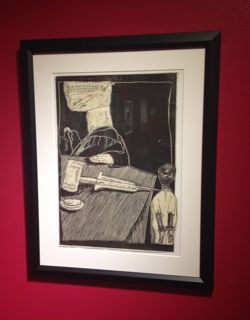
“Network of Mutuality” examining the legacy of the Civil Rights Movement
A provocative and reflective exhibition of art closed yesterday, December 1: “Network of Mutuality: 50 Years Post-Birmingham.” The exhibition was part of the Levine Museum of the New South’s long-term project: “Destination Freedom: Civil Rights Struggles Then and Now,” which is a two-year series of programs and exhibits exploring the legacy of the Civil Rights Movement. “Network of Mutuality” exhibited art works from leading contemporary artists and designers that tackle the various social conditions that energized the Civil Rights Movement in the 1960s, as well as current issues of race, representation and otherness.
Of the many important and captivating art works on view in “Network of Mutuality,” the works that created a strong connection between the Civil Rights struggles of the 1960s and today had the most impact. Archie Boston’s “We’ve Come Too Far” is a simple and direct black-and-white poster that forces the viewer to confront the power of words. The work features a series of dates and a corresponding name for African Americans, ending the list with a blank line for today, which asks the viewer to fill in his or her own word. It would have been a really eye-opening interactive component if the museum had provided paper and pen for visitors to fill in the blank.
Archie Boston, “We’ve Come Too Far,” 2000.
Another engaging work was Frances Jetter’s “The Executioner’s Wrong—Texas Will Execute Gary Graham for a Murder He Almost Certainly Didn’t Commit.” Jetter’s unique sketchy style in striking black and white offers a blunt interpretation of the controversial case of Gary Graham in the 1980s, raising questions about the high number of executions in Texas and other Southern states, as well as the fact that most executions are of African Americans.
Frances Jetter, “The Executioner’s Wrong – Texas will execute Gary Graham for a Murder he Almost Certainly Did Not Commit,” 1993.
Michael Booker’s sculptural piece “Mississippi: Since 1894” is an amalgamation of architectural scraps, including a shutter, door, bricks, baseboard and chairs. With this piece, Booker reflects on his home state’s history and its adoption of the “stars and bars” battle flag on to its state flag in 1894, and the 2001 effort to create a new flag sans “stars and bars” – an effort that failed. Booker’s work suggests the progress made in struggles for racial equality or lack thereof, and the symbolism of the closed shutter and door hint at the resistance to discuss racial issues in a “post-racial” era.
Michael Booker, “Mississippi: Since 1894,” 2011
Finally, the first work that visitors encountered upon entering “Network of Mutuality” was Michael Paul Britto’s “African Klan Suit #2,” which features a Ku Klux Klan outfit re-created from Kente cloth. The mannequin is posed in an intimidating posture with arms crossed and the shape of the costume is unmistakable, yet Britto’s use of a traditional West African fabric somehow re-claims this costume, urging viewers to re-think its power and meaning.
The years 2013 through 2015 mark important anniversaries in the Civil Rights Movement, from the March on Washington and Martin Luther King’s “I Have a Dream” speech, to the bombing of the Sixteenth Street Baptist Church and then the signing of the Civil Rights Act in 1964. In light of these anniversaries the Levine Museum decided to take the opportunity to reflect on and commemorate these important milestones, as well as draw attention to today’s struggles for rights and freedoms among people of various backgrounds. Other exhibitions part of “Destination Freedom” include “Focus on Justice” August 24 to January 26, 2014, “View From the Other Side” August 24 to February 2, 2014 and “Out of the Shadows” December 21 to June 29, 2014. If you missed “Network of Mutuality,” do not fail to see one of the other exhibitions part of “Destination Freedom.”
Levine Museum of the New South: 200 E. Seventh Street, Charlotte; 704-333-1887; www.museumofthenewsouth.org
Recent Content
-
Artsarticle ·
-
Artsarticle ·
-
Artsarticle ·



